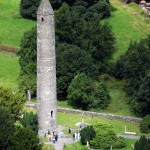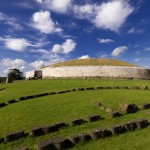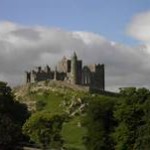This Ancient East Explorer 8 night tour travels off the beaten track to see, hear, touch and feel the imprints of the millennia of settlers in this land.
Want to visit Ireland? Why not visit the castles in Ireland along Ireland’s Ancient East!!
A time when legends were born, pagan gods roamed the Earth and Kingdoms of Ireland were won and lost with a swing of the broadsword. As day became night and decades became centuries, magic became myths but nothing is ever truly gone and their stories are written in the land, actions are still felt but to unearth this story you have to go back to the beginning and the places where it all started. This itinerary allows you to get off the beaten track and explore the remnants of the Ancient Man, Early Christians, Medieval Lords and Colonial Settlers. Hear for yourself their stories. Discover tombs older than the pyramids, walk a medieval mile, be moved at monasteries and imagine a more genteel life in one of the many historic big houses.
Overnight Locations:
Night 1 – Wicklow
Night 2 & 3 – Waterford
Night 4 – Cork
Night 5 – Tipperary
Night 6 & 7 – Meath
Night 8 – Dublin
![9H0A6871[1]](http://www.myholidayireland.com/wp-content/uploads/9H0A68711-800x520.jpg)
Not looking for a bus tour Ireland/holiday to Ireland? Check out Let’s go Travel and Limerick Travel for options to other destinations!
| Low Season | B&Bs | 3 * Hotel | 4* Hotel |
| Bed & Breakfast for 8 nights and Rental of an Economy Manual car | €497 pps | €690 pps | €852 pps |
| High Season | B&BS | 3* Hotel | 4*Hotel |
| Bed & Breakfast for 8 nights and Rental of an Economy Manual car | €655 pps | €913 pps | €1,100 pps |
pps=per person sharing
Tour package Includes :
- Economy Manual vehicle eg., Ford Fiesta with unlimited mileage based on a minimum of 2 people travelling together. Inclusive of: Collision Damage Waiver (CDW), theft protection (TP), government tax (VAT) and Location Service Charge (upgrade rates for larger or automatic transmissions are available on request).
- Full breakfast daily except on day one
- All local taxes and hotel service charges
- Confirmation documents for each of your accommodations including driving directions
- All rates above are per adult sharing, child and single supplements apply
- Low Season- November-March
- High Season- April-October
Dublin to Wicklow
Today you will be traveling south through County Wicklow, also known as the ‘Garden of Ireland’. First stop will be Powerscourt House & Gardens. Surrounding this 18th Century Palladian House in the foothills of the Wicklow Mountains, you will find a sublime blend of formal gardens, sweeping terraces, statuary and ornamental lakes together with secret hollows, rambling walks and over 200 varieties of trees and shrubs. Shortly after this, you will arrive at the ancient monastic settlement at Glendalough. Glendalough “the glen of the two lakes” is a truly spellbinding place – an ancient monastic settlement and two clear water lakes beneath the sheer cliffs of a deep valley, which was carved out by glaciers during the Ice Age. The monastic settlement has been a centre for pilgrims and visitors since its foundation by St. Kevin in the 6th century. From here, follow the signs for Avondale House. Built in 1779 Avondale House is set in the spectacular surroundings of Avondale Forest Park, now a museum to the memory of one of the greatest political leaders of modern Irish history, Charles Stewart Parnell, who was born in Avondale on 27th June, 1846. Continue onto Mount Usher Gardens which was first planted in 1868 in Robinsonian style , after the Irish garden designer William Robinson who emphasised informal planting in harmony with the natural setting of the garden.
Wicklow to Waterford
From Arklow, travel to Enniscorthy in the neighbouring county of Wexford. Enniscorthy is an old Norman settlement and is situated on the banks of the River Slaney overlooked by the old 1798 battle site of Vinegar Hill. Dominating the town is the Norman Castle which was completed in 1205 and now houses the County Wexford Folk Museum. Traveling down the N30 to New Ross, it is well worth stopping at the Dunbrody Famine Ship. The Visitor Experience provides a unique, authentic re-creation from a period in history which shaped modern day America and Ireland. Time permitting, you can take an alternative route to Waterford via the Wexford coast road. This coastal region is rich in heritage sites, tranquil villages, breathtaking scenery and warm hospitality. The major sites along this coastal route include the ancestral home of the Kennedy family, Hook lighthouse and Dunbrody Abbey. From New Ross, it is only 25 minutes to Waterford City. Waterford Crystal has a long tradition of extending a warm welcome to tourists from all over the world. There is now a new Waterford Crystal manufacturing facility, retail outlet and visitor centre in the heart of Waterford city which employs 80-90 full-time staff at the facility, a number of whom will be highly skilled local craftsmen. Also in Waterford is the Waterford Treasure Museum close to the Waterford Crystal facility.
Waterford to Cork
The following route includes visits to Midleton, Youghal, Cobh & Blarney. Youghal is famous for its point lace (point d’Irlande) which is distinguished by its vivid patterns as well as the fact that the film ‘Moby Dick’ starring Gregory Peck was filmed here in 1956. After Youghal, you will travel to the village of Cobh. Cobh, situated on one of the world’s largest natural harbours, was the last port of call for the ill-fated Titanic in 1912 and was the closest port to the site of the sinking of the Lusitania in 1915. The heritage centre sympathetically recounts these events and tells the story of emigration from Ireland to the United States and Australia from the time of the famine in 1847 up to the 1950s. A stop to climb to the Blarney Castle ramparts to ‘Kiss the Blarney Stone’, said to bestow the gift of eloquence, and is a must for those who dare. The alternative route to Kinsale takes you via the Rock of Cashel and Cahir Castle 2 of Ireland’s most historic attractions. Cahir Castle, once an important stronghold of the powerful Butler family, which retains its impressive keep, tower and much of its original defensive structure. It is one of Ireland’s largest and best-preserved castles. 10 miles further on and you arrive at the Rock of Cashel. Cashel was once the seat of the Kings of Munster and capital of this southern province. Kings of Ireland as well as Munster came to this spot and St. Patrick is known to have preached on the rock and converted the local King, Aenghus, here in the 5th Century. On to Kinsale. Kinsale is a delightful harbour town that has retained its old world charm and character despite being well developed from a tourism point of view with its beautiful waterside location, local facilities including a yacht marina and historic buildings such as Desmond Castle and Market House as well as Charles Fort overlooking the sea and town. Kinsale styles itself as the gourmet capital of Ireland, boasting numerous excellent restaurants and atmospheric traditional pubs.
Cork To Tipperary
The direct route to Cashel will take in the region of 2 hours to drive (stops not included). An alternative route would be to travel via Blarney Castle where a climb to the Castle ramparts will allow you the opportunity to ‘Kiss the Blarney Stone’ for the ‘Gift of Eloquence’ in County Cork. Next stop is Cahir Castle, once an important stronghold of the powerful Butler family, which retains its impressive keep, tower and much of its original defensive structure. It is one of Ireland’s largest and best-preserved castles. 10 miles further on and you arrive at the Rock of Cashel. Cashel was once the seat of the Kings of Munster and capital of this southern province. The Rock of Cashel, which rears above the plain, dominated the land routes southwards. Kings of Ireland as well as Munster came to this spot and St. Patrick is known to have preached on the rock and converted the local King, Aenghus, here in the 5th Century. Brian Boru was also crowned King of Ireland on this spot in the early 11th Century. King Cormac built his superb Royal Chapel in the 12th century. Visit Cashel town to experience and understand the historical relationship between the Rock and the town. Turn the key to the rich heritage in Cashel such as the archaeology, fine architecture, fascinating history and folklore of this remarkable town.
Tipperary to Meath
From Cashel you will travel north to Kildare where you will have the opportunity of visiting The Japanese Gardens. The Japanese Gardens are situated in the grounds of the Stud Farm and were created between 1906 and1910. They are planned to symbolise the ‘Life of Man’ from the cradle to the grave. You can also visit The National Stud. The National Stud is home to some of Ireland’s finest thoroughbreds. There’s a Horse Museum tracing the history of the horse in Ireland using artifacts, illustrations and text and the skeleton of the legendary steeplechaser ‘Arkle’. In fact the winner of the 2003 Californian ‘Breeders Cup Mile’ race is a National Stud horse, the 3rd in the last 9 years. From here travell North to Ireland’s most visited attraction, the megalithic tombs in Newgrange. One of the great wonders of the ancient world, Newgrange is older than Stonehenge, Mycenae or even the Pyramids of Egypt. Also in this historic county of Meath, you will find the seat of the ancient kings of Ireland at the Hill of Tara as well as the splendid Trim Castle, just north of Dublin.
Meath to Dublin
From here, we travel south to Dublin City. Dublin city centre is a compact area, with all points of interest being easily accessible on foot. As a result you will find a large number of walking tours available, the most popular of which include the “Historical Walking Tour” and the “Literary Pub Crawl”. You may of course wish to visit many of the sights in your own time either on foot or with the Hop-On-Hop-Off bus service that stops at all of the major attractions including Dublin Castle, Trinity Castle & the Book of Kells, Kilmainham Gaol, the National Museum of Ireland and The Guinness Storehouse to name just a few. Also whilst in Dublin visit the Jeanie Johnston Tall ship & Famine Museum situated at Custom House Quay in the city centre. The Jeanie Johnston Tall ship is an accurate replica of the original ship which sailed between Tralee, Co. Kerry and North America between 1847 and 1855. A tour of the ship enables visitors to understand what a daunting experience it was for the millions who left for North America during the famine, many never to return to the homeland.
Glendalough

An Early Christian site founded by St.Ciarán in the mid-6th century on the eastern bank of the River Shannon. The site includes the ruins of a cathedral,seven churches (10th -13th century),two round towers, three high crosses and the largest collection of Early Christian grave slabs in Western Europe. The original high crosses and a selection of grave slabs are on display in the visitor centre. The long and varied history of Clonmacnoise is recounted in an audio-visual presentation shown in the visitor centre.
Clonmacnoise 
An Early Christian site founded by St.Ciarán in the mid-6th century on the eastern bank of the River Shannon. The site includes the ruins of a cathedral,seven churches (10th -13th century),two round towers, three high crosses and the largest collection of Early Christian grave slabs in Western Europe. The original high crosses and a selection of grave slabs are on display in the visitor centre. The long and varied history of Clonmacnoise is recounted in an audio-visual presentation shown in the visitor
centre.
Brú na Bóinne 
Brú na Bóinne is one of the largest and most important prehistoric megalithic sites in Europe. Declared a World Heritage Site by UNESCO in 1993, the site is dominated by three large passage tombs – Newgrange, Knowth and Dowth. Art is one of the most
important features of the monuments and Knowth has nearly 30% of all megalithic art in Europe. According to UNESCO it represents a masterpiece of human creative genius.
Rock of Cashel 
One of Ireland’s most iconic attractions, the site comprises a spectacular group of Medieval buildings set on an outcrop of limestone in the Golden Vale including the 12th century round tower, High Cross and Romanesque Chapel, 13th century Gothic cathedral, 15th century castle and the restored Hall of the Vicars Choral. Attractions include an audio-visual show and exhibitions.
Not looking for a bus tour Ireland/holiday to Ireland? Check out Let’s go Travel and Limerick Travel for options to other destinations!
